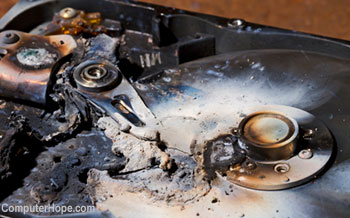Data loss
Updated: 10/01/2023 by Computer Hope

Data loss describes any scenario where data on a storage device is corrupted, deleted, or destroyed. Generally, when data loss occurs, a user is required to restore what's missing from a backup.
Reasons for data loss
The following list contains many of the different ways data loss occurs.
- Deleted data - Data mistakenly or intentionally deleted can result in loss unless recovered through software.
- Information not saved - Not all programs autosave; if a computer restarts or the program closes without saving, all work since the last save is lost. Unless the program has an auto-recovery feature.
- Corrupted data - Data can become corrupted for many reasons. When this happens, it can't be read by a device and is no longer useful.
- Hardware damage - Defects or damage to a storage device can cause data not to be written properly, corrupt, or inaccessible. When this occurs, it is usually only recoverable by restoring from a backup.
- Moved data - If data is moved to another location, it is not necessarily lost if it's found and moved back. However, if it's an online location that's no longer available, the data is lost unless that online location returns. Moved data also applies to any external drive no longer connected to the computer.
- Infected data - If the data is infected with a virus or other malware, it can become so corrupted it cannot be restored without a backup.
- Stolen data - If your computer is attacked, data may be lost because it's stolen by the attacker.
- Locked data - Ransomware is designed to lock data and ransom you for the unlock key. If you refuse to pay, consider your data lost.
Data, Data acquisition, Data loss prevention, Data recovery, Security terms, Software terms
